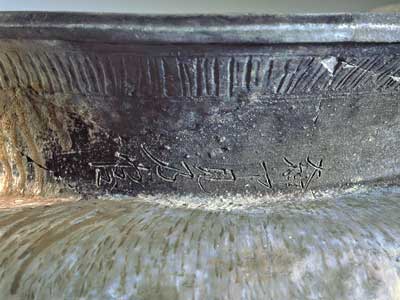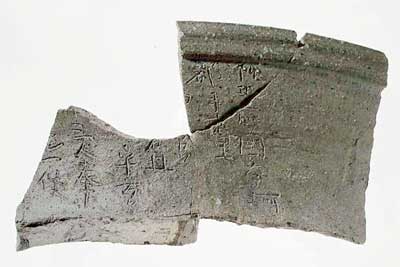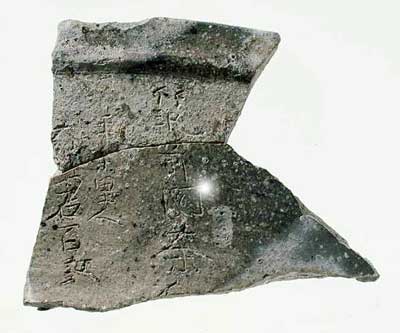Ushikubi:
Investigation of the largest Sue ware kiln site group in Kyushu.
Precious documentary materials are added for the Wadō era
(708-715).
Ushikubi Kiln Site Group, Ōnojō City, Fukuoka Prefecture
Kyushu’s largest Sue ware production district
The Ushikubi kiln site group, in the eastern portion of the Fukuoka plain, is the largest Sue ware kiln site group of its kind in Kyushu. The kilns were operated for approximately 300 years, from the Late Kofun (around the mid-sixth century) to beginning of the Heian periods (around the mid-ninth century), and during the Nara period (eighth century) its products were taken to every part of Kyushu.
More than 300 kiln remains have been investigated to date, and as over 100 more are known to survive among the hills, a total in excess of 500 kilns is surmised.
Sue vessels with incised writing are found
Charcoal and misshaped Sue items discarded after firing are found in ash piles which spread over the area below the remains of each kiln. Among the discards are items inscribed with characters. Characters were written while the clay was not yet dry after the vessel had been shaped, and these items are called heragaki (meaning “spatula-incised writing”) Sue ware. Thirty-eight have been recovered from the Ushikubi kiln site group
What do the characters tell?
Among the inscribed items are those indicating that three individuals from the administrative village of Shutō in Naka district, in the ancient province of Chikuzen, were paying a tax in kind called chō, in the form of large Sue jars, in the year 713. A ninth century record of administrative regulations, contained in the Engishiki, indicates that men of Chikuzen paid their chō tax in groups of three, and strictly stipulates the vessel type, size, and format of payment notification. Examples conforming to these regulations were found among the incised Sue items.
Among the inscribed names of artisans, those of Ōmiwa no Kimi and Ōmiwabe are most frequent, showing them to be central figures among artisans of the Ushikubi kiln site group. Families of Miwa descent, such as Ōmiwabe, and Miwa no Atai and Miwahitobe, are known to have been connected with Sue production, and their involvement is also seen in the ancient provinces of Izumi (in Osaka prefecture) and Tōtōmi (in Shizuoka prefecture). The Sue vessels with incised writing are precious materials shedding light on the nature of tax payments in the ancient period. (Ishiki Hidetaka)
(principal artifacts, Ushikubi Kiln Site Group)
 Large jar recovered from the Hondō site group, Excavation No. 7, valley area Asuka period (first half to the middle decades of the seventh century). Diameter: 46.7 cm. This was recovered from the Kamiōri district in Ōnojō, more than 2.5 km north from the Hasemushi kiln site group. The inscribed characters form a column placed horizontally along the neck of the jar. Written in an excellent hand, the level of quality is high even in comparison with ink-written materials, or inscriptions in stone or metal, of the same period. The final character, |
 Large jar
recovered from the Hasemushi site group, Location 12
Large jar
recovered from the Hasemushi site group, Location 12Nara period, the year Wadō 6 (713). Width: 42 cm. The payment of a single large Sue jar as chō tax by Ōmiwabe Tokushin and two others in the year Wadō 6 (713) is recorded. The payment of a single large Sue jar by three persons is in accordance with regulations noted in the Engishiki. Also, the village name seen in the inscription ( |
 Large jar recovered from the Hasemushi site group, Location 12 Nara period, first half of the eighth century. Width: 23 cm. This inscription, with nearly the same content as the Wadō 6 (713) item introduced above, may be seen as from the same year, but the names of the three persons intending the payment of this jar appear to be different. Also, while the modern characters |
 Large jar recovered from the Hasemushi site group, Location 12 Nara period, the year Wadō 6 (713). Width: 15 cm. This also has almost the same content as the Wadō 6 (713) item previously introduced, with the names of the three persons intending the payment of the jar being different. From these three items it is presumed that 9 artisans are ascertained as having paid their chō tax in the year 713. |
 Large jar recovered from the Hasemushi site group, Location 12 Nara period, first half of the eighth century. Width: 13 cm. Differing from the previous three items, here the descriptor |
 Jar recovered from the Tsukahara site group Nara period, first half of the eighth century. Width: 12.5 cm. This was recovered from a settlement over 1 km north of the Hasemushi kiln site group. As the surname Oshisaka |


